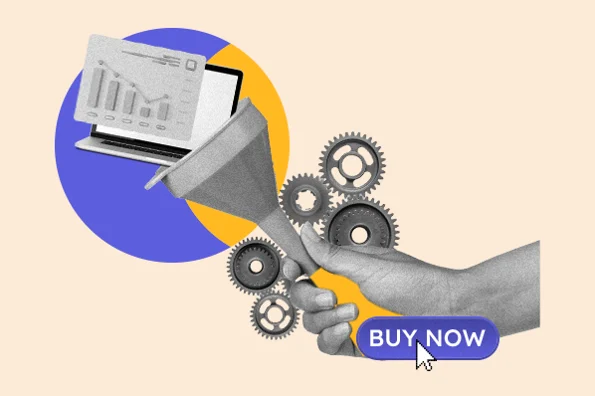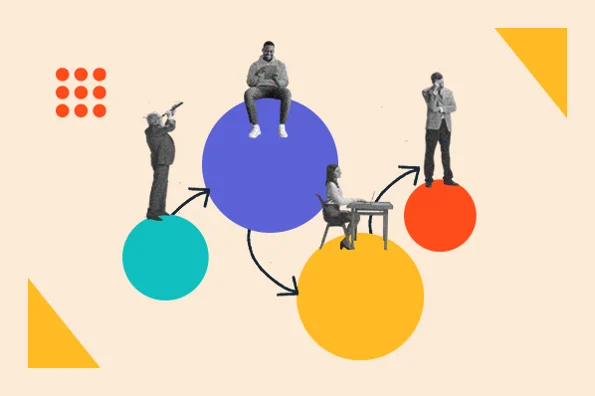Personal selling involves direct communication between a salesperson and a potential customer. This can occur in person, over email, on the phone, or via video.
Personal selling is most commonly used for business-to-business (B2B) selling, although it can also be used in retail and trade selling.
Personal Selling Advantages and Disadvantages
As with any business methodology, personal selling comes with its pros and cons. Weigh the following before implementing personal selling in your business.

Personal Selling Advantages
Personal selling gives you a leg up. A whopping 92% of all customers expect a personalized experience. What’s more, 80% of consumers are more likely to buy from companies that nail personalization.
It should come as no surprise that personal selling offers several critical advantages. That includes the following.
You can build strong relationships.
You can use detailed and personalized communication to build trust and develop strong relationships with clients.
You can handle objections quickly.
Your sales team can tailor responses to questions, concerns, or objections potential customers may have based on specific knowledge of their needs. This can ultimately move them closer to purchase.
You can assess needs and deliver support.
Using the personal, one-on-one approach allows you to better assess prospects’ needs. That includes what their goal is and why they’re interested in your product. You can then deliver the right type of support.
You can achieve greater success rates.
With a personal relationship, your salespeople are 50% more likely to make the sale at about a third of the cost of traditional methods.
You can reduce churn.
By building a strong relationship, you’re more likely to deliver on clients’ needs and build loyalty. This makes them less likely to leave.
Deeper connections lead to stronger relationships and a greater degree of trust and loyalty. When you show your customers you care, they’ll reward you with their business and referrals.
Personal Selling Disadvantages
Few disadvantages come with personal selling. Typically, it’s a process that reaps more positive outcomes for businesses than not.
With that said, it’s wise to be aware of any possible drawbacks that your team might encounter.
Personal selling is resource intensive.
Because research takes as much as 6 hours a week, personal selling can seem more expensive on the front end. However, the payoff is often worth the investment.
Success takes time.
Hitting as many prospects as possible in a short period may yield more immediate sales than personal selling. However, the personalized nature of personal selling gives you stronger relationships and a higher close rate long-term.
Your pool may be smaller.
While reps cannot reach a large pool of people at once, they devote time to identifying good-fit — and therefore, more qualified — leads in the process.
As you might already see, these drawbacks usually lead to greater advantages and positive outcomes.
Think about it this way: Although personal selling can be expensive, time-consuming, and labor-intensive, these factors also mean reps are fostering strong, trusting relationships with qualified leads. These leads are more likely to convert into paying customers and stick around for a long-term partnership.
Now, let’s review a common approach to the personal selling process and what it entails.
The personal selling process consists of seven equally important steps. Each allows your sales team to better understand and serve your prospects and customers — ultimately leading to higher close rates and customer satisfaction.
Download these 101 questions to ask contacts when qualifying, closing, negotiating, and upselling.
1. Prospecting
The first step in the personal selling process is seeking out potential customers — also known as your prospects or leads.
Prospecting can be done through inbound marketing, cold calling, in-person networking, or online research that includes LinkedIn and other social media.
An important part of the prospecting stage is lead qualification. Remember, personal selling is all about finding solutions for your customers. However, not everyone is fit to be a customer.
By gathering as much information as possible about your prospects before hopping on a call, you’ll make the most of your time. What’s more, you’ll also demonstrate that you’ve done your research.
While lead qualification is time-consuming, it’s worth your time. Two-thirds of lost sales are due to sales reps not qualifying leads.
Therefore, you must qualify your leads to avoid spending precious time and resources on prospects who have little to no chance of becoming customers — and to minimize customer churn.
2. Pre-approach
During the pre-approach stage, your sales team should prepare to make initial contact with any leads they’ve discovered while prospecting.
Pre-approach typically involves extensive online research about the prospect, the market, and his or her business. This stage also includes building and practicing a sales presentation tailored to the prospect.
3. Approach
In this stage, the sales team should make initial contact with a prospect by reaching out, introducing themselves, and starting a conversation. This might happen via a phone call, video call, email, or in person.
The ultimate goal of the approach stage is to better understand the prospect and know their wants, needs, and problems. For this reason, your sales team should focus on asking questions in this stage to know if and how your product can solve their pain points.
What you learn from those questions will help you tailor your presentation to speak to their specific needs.
4. Presentation
In the presentation stage, your sales team shares your product or service.
Throughout the presentation, your sales team should focus on how your offering benefits the prospect, using information gathered in the pre-approach and approach stages. This will ensure the presentation is relevant to the prospect and their needs.
5. Handling Objections
At this point in the personal sales process, a prospect will likely have questions and objections. It’s the job of your sales team to correct any misconceptions, handle any objections, and answer any questions — without seeming pushy or losing trust.
The purpose of this stage isn’t to change a prospect’s mind or force them to buy. On the contrary, it’s simply to learn more about how to best help the prospect reach a solution.
If your prospect doesn’t reach out with any questions, encourage your team to follow up to see how they can help.
6. Closing
After overcoming any objections and barriers to the sale, your team should try to finalize the sale — otherwise known as “closing” the deal. This stage involves settling any negotiations, payments, invoices, contracts, or paperwork to wrap up the deal.
7. Follow-up
The final stage of the personal selling process is to follow up. Here, your sales team contacts the customer after a sale to ensure they’re having a great experience and receive effective onboarding.
This stage is important because it allows your sales team to maintain customer relationships. This can secure future renewals and upgrades.
Following up also gives you insights into potential challenges and allows you to connect customers with your service team if necessary. Customer service is critical.
- 90% of Americans use customer service as a factor in deciding whether or not to do business with a company.
- 80% of American consumers will switch providers because of poor customer service.
- 89% of consumers are more likely to make another purchase after a positive customer service experience.
More importantly, happy customers become brand advocates who refer you to their friends and colleagues. And not only are people 92% more likely to trust referrals, but up to 87% of marketers and sales reps agree that referrals are the strongest leads.
For that very reason, you might say that there’s an eighth step — asking for referrals. This should be part of your ongoing follow-up process. Because you want to ensure customer satisfaction before asking for a referral, it remains part of the seventh step.
Now, we’ll review some strategies you can incorporate into your personal selling process to make the most of your efforts.
Personal selling can be a complicated job. Here are some personal selling strategies to help diversify the way your team approaches selling to customers.
1. Be natural and personable.
The first thing your sales reps are selling is themselves. If a prospect doesn’t like a rep, they won’t trust anything they say.
Encourage your team to ask questions and build two-sided relationships. Having greater connections and natural conversations allows you to show empathy, all while opening the door to sharing success stories and building trust.
2. Remember your buyer personas.
As your team prospects and qualifies leads, ensure they remember your organization’s buyer personas. If your company typically targets customers with a certain budget or team size, don’t waste time working with leads outside of those specifications.
Salespeople often make the mistake of trying to sell to anyone and everyone. However, by focusing on nurturing good-fit leads, they’re 50% more likely to make the sale, and at 33% lower costs.
3. Ask the customer plenty of questions.
Your team should listen more than they talk. They won’t know how to help and sell to customers if they don’t know their questions or concerns.
Also, encourage reps to ask questions about what motivates prospects. Here, you can learn what features match your prospects’ goals and needs.
4. Focus on end benefits, not product features.
Once your team learns about what your prospect needs, have reps focus on explaining how the prospect will benefit from your offering.
Consider making a list of all the benefits your product offers. This can help you paint a picture of how you can help customers. This preparation will help your reps talk with your customers instead of talking at them.
5. Personally address any customer concerns.
As your team works with potential customers, they should consider themselves personal advocates. If prospects have any concerns or questions, your reps should do their best to personally address each objection.
This builds trust with prospects and moves them closer to purchase. After all, 88% of customers say trust is the most important thing, even in times of change.
6. Ask for the sale.
Fourty-eight percent of sales calls end without an attempt to close it — which decreases the likelihood of success.
Your team should ask for the sale after you address any concerns or objections. Research and test various closing phrases to see what comes naturally to your sales team.
7. Follow up after purchase.
Your relationship with your customers doesn’t end once they buy your product or service. The simple act of following up can be a differentiator. In fact, 48% of salespeople never follow up.
Following up with customers (via phone, email, or in person) keeps the relationship alive.
8. Consider using email tracking software.
Personal selling involves a great deal of tailored communication and interactions with leads and prospects. Email tracking software can alert your team when potential customers open their emails so they know who’s interested and who to follow up with to stay top-of-mind.
While 88% of people are more likely to respond to personalized emails, knowing how many times each email is opened gives you strong indications about how interested people are, even if they don’t respond.
In this section, we’re going to review a handful of businesses that use personal selling. While personal selling is used across industries, we chose examples that illustrate significant purchase decisions that often require a close relationship between a salesperson and prospect.
Get inspired below.
Software
When customers buy software, especially for their department or company, there’s a lot involved. Buyers need to weigh a full suite of tools and a variety of solutions.
Plus, customers will require buy-in across their company. Most business buying journeys involve between 6 and 10 decision-makers, so the sales cycle can be lengthy.
For these reasons, personal selling in the software industry becomes necessary to best serve customers. The salesperson can help customers understand how the tool can be tailored to their needs and articulate the features to others in their organization.
A prime example of personal selling for department-wide software is HubSpot. HubSpot offers a range of software solutions for marketing, sales, and customer service. This requires the sales team to spend time prospecting and educating customers about how these tools can help their businesses.
Other examples include Workday for human resources, Slack for business enablement, and Xero for accounting.
Catering
Catering companies base their services on events — and because each event is different, they must customize their offering based on what each customer needs. For this reason, caterers employ salespeople that speak with prospects to better understand their needs.
These salespeople are also responsible for building a custom catering plan for customers, managing the execution of the service, and checking up on customers after the event(s). These are all important parts of the personal selling process.
Travel
Travel is another industry that relies on personal selling. Salespeople must explain each travel experience in detail, conduct more intimate conversations about what a customer wants, and present multiple travel options before a customer makes a purchase.
Office Equipment
Companies often need to make office-wide equipment purchases — for chairs, computers, desks, and more. This process typically requires personal rapport between the office equipment salesperson and the business.
Not to mention, office equipment is a competitive space. For this reason, salespeople must work to understand the customer’s needs and explain why their product is the best choice.
Real Estate
Real estate, for both individuals and businesses, is a significant purchase. Aside from the sheer cost of real estate, the purchase process involves detailed questions as well as multiple property walkthroughs (which are synonymous with sales presentations).
For this reason, real estate agents are responsible for finding good-fit prospects and educating them on each property.
Start Personal Selling
Personal selling centers around a genuine interest in helping customers solve their problems using your product or service — not forcing a sale for the sake of quotas or the bottom line.
Encourage your sales team to use these strategies to build and maintain authentic relationships with your customers. Soon, your customers will become strong advocates for your brand.
Editor's note: This post was originally published in October 2019 and has been updated for comprehensiveness.
Sales Process




![Want to Create a Sales Plan? Let Me Show You How [+ 10 Sales Plan Examples]](https://53.fs1.hubspotusercontent-na1.net/hubfs/53/how-to-create-a-sales-plan-1.jpg)
![The Ultimate Sales Cheat Sheet Template to Help Boost Rep Success [New Data + Templates]](https://53.fs1.hubspotusercontent-na1.net/hubfs/53/ft-cheat.webp)
![How to use battle cards in your sales process [+ templates]](https://53.fs1.hubspotusercontent-na1.net/hubfs/53/%5BUse-Oct-08-2025-10-11-09-0787-PM.webp)



.jpg)

